Marantz SR7011 Owners Manual
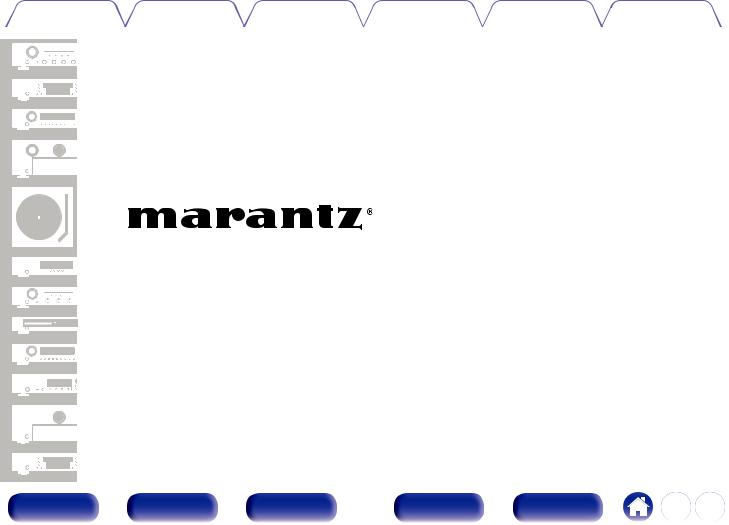
Contents |
Connections |
Playback |
Settings |
Tips |
Appendix |
|
|
|
|
|
|
AV Surround Receiver
SR7011
Owner’s Manual
Front panel |
Display |
Rear panel |
1 |
Remote |
Index |
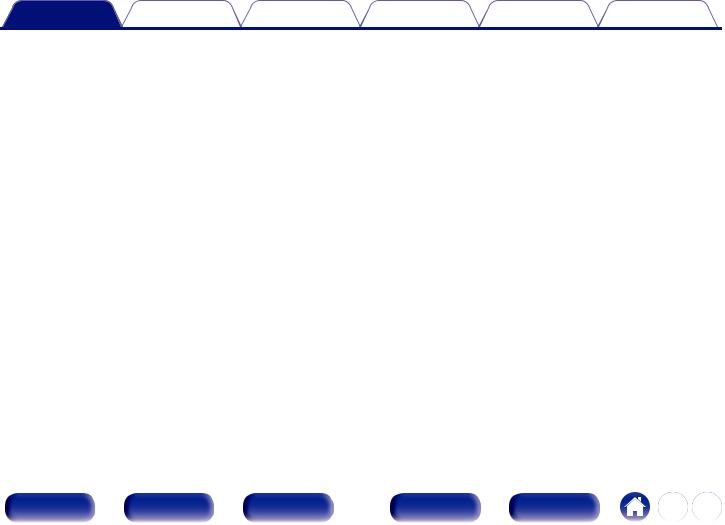
Contents |
Connections |
Playback |
Settings |
Tips |
Appendix |
Upgrade |
7 |
|
|
Accessories |
8 |
|
|
|
Inserting the batteries |
9 |
|
|
Operating range of the remote control unit |
9 |
|
|
Features |
10 |
|
|
High quality sound |
10 |
|
|
High performance |
12 |
|
|
Easy operation |
16 |
|
Part names and functions |
17 |
|
|
|
Front panel |
17 |
|
|
Display |
22 |
|
|
Rear panel |
26 |
|
|
Remote control unit |
30 |
|
Connections |
|
|
|
Connecting speakers |
35 |
|
|
|
Speaker installation |
35 |
|
|
Speaker connection |
44 |
|
|
Speaker configuration and “Amp Assign” settings |
48 |
|
|
Connecting a TV |
77 |
|
|
Connection 1 : TV equipped with an HDMI connector and |
78 |
|
|
compatible with the ARC (Audio Return Channel) |
|
|
|
Connection 2 : TV equipped with an HDMI connector and |
79 |
|
|
incompatible with the ARC (Audio Return Channel) |
|
|
|
Connection 3 : TV equipped without an HDMI connector |
80 |
|
Connecting a playback device |
81 |
|
|
|
Connecting a set-top box (Satellite tuner/cable TV) |
82 |
|
|
Connecting a DVD player or Blu-ray Disc player |
83 |
|
|
Connecting a video camcorder or game console |
84 |
|
|
Connecting a turntable |
85 |
|
|
Connecting a device with a multi-channel output connector |
86 |
|
|
Connecting a USB memory device to the USB port |
87 |
|
Connecting an HD Radio antenna |
88 |
|
|
Connecting to a home network (LAN) |
90 |
|
|
|
Wired LAN |
90 |
|
|
Wireless LAN |
91 |
|
|
Connecting an external control device |
92 |
|
|
REMOTE CONTROL jacks |
92 |
|
|
DC OUT jacks |
93 |
|
|
Connecting the power cord |
94 |
|
Playback |
|
|
|
Basic operation |
96 |
||
|
Turning the power on |
96 |
|
|
Selecting the input source |
96 |
|
|
Adjusting the volume |
97 |
|
|
Turning off the sound temporarily (Muting) |
97 |
|
|
Playback a DVD player/Blu-ray Disc player |
97 |
|
Front panel |
Display |
Rear panel |
2 |
Remote |
Index |
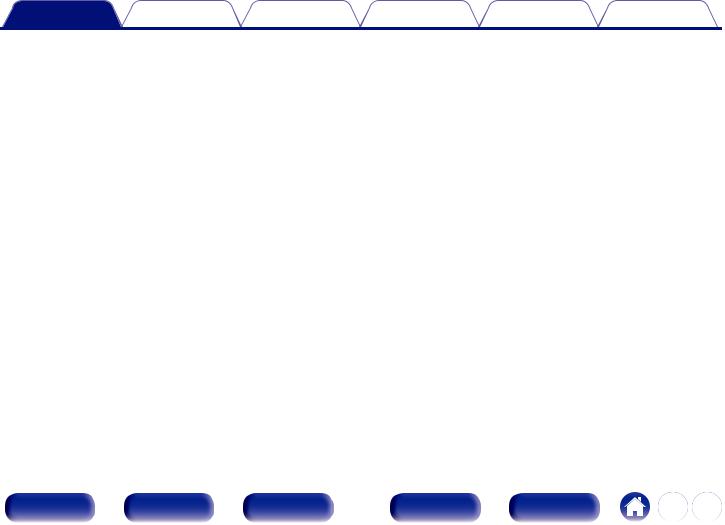
Contents |
Connections |
Playback |
Settings |
Tips |
Appendix |
Playing a USB memory device |
98 |
|
|
Playing files stored on USB memory devices |
99 |
|
Listening to music on a Bluetooth device |
102 |
|
Playing music from Bluetooth device |
103 |
|
Pairing with other Bluetooth devices |
105 |
|
Reconnecting to this unit from a Bluetooth device |
106 |
|
Listening to an HD RadioTM station |
107 |
|
Listening to an HD Radio station |
109 |
|
Tuning in by entering the frequency (Direct Tune) |
111 |
|
Changing the tune mode (Tune Mode) |
111 |
|
Selecting an audio program |
112 |
|
Tuning in to stations and presetting them automatically (Auto |
112 |
|
Preset Memory) |
|
|
Presetting the current broadcast station (Preset Memory) |
113 |
|
Listening to preset stations |
113 |
|
Specify a name for the preset broadcast station (Preset Name) |
114 |
|
Skipping preset broadcast stations (Preset Skip) |
115 |
|
Cancelling Preset Skip |
116 |
|
Checking the HD Radio reception information |
117 |
|
Listening to Internet Radio |
118 |
|
Listening to Internet Radio |
119 |
Playing back files stored on a PC or NAS |
120 |
|
|
Playing back files stored on a PC or NAS |
121 |
Getting the HEOS App |
124 |
|
|
|
HEOS Account |
125 |
|
|
Playing from streaming music services |
126 |
|
|
Listening to the same music in multiple rooms |
129 |
|
AirPlay function |
133 |
||
|
Playing songs from your iPhone, iPod touch or iPad |
134 |
|
|
Playing iTunes music with this unit |
134 |
|
|
Selecting multiple speakers (devices) |
135 |
|
|
Perform iTunes playback operations with the remote control unit |
135 |
|
|
of this unit |
||
|
|
|
|
Spotify Connect function |
136 |
|
|
|
Playing Spotify music with this unit |
136 |
|
|
Convenience functions |
137 |
|
|
Adding to HEOS Favorites |
138 |
|
|
Playing back HEOS Favorites |
138 |
|
|
Deleting a HEOS Favorites |
139 |
|
|
Adjusting the volume of each channel to match the input source |
140 |
|
|
(Channel Level Adjust) |
||
|
Adjusting the tone (Tone) |
141 |
|
|
|
|
|
|
Displaying your desired video during audio playback (Video |
142 |
|
|
Select) |
||
|
|
|
|
|
Adjusting the picture quality for your viewing environment (Picture |
143 |
|
|
Mode) |
||
|
Playing the same music in all zones (All Zone Stereo) |
144 |
|
Front panel |
Display |
Rear panel |
3 |
Remote |
Index |
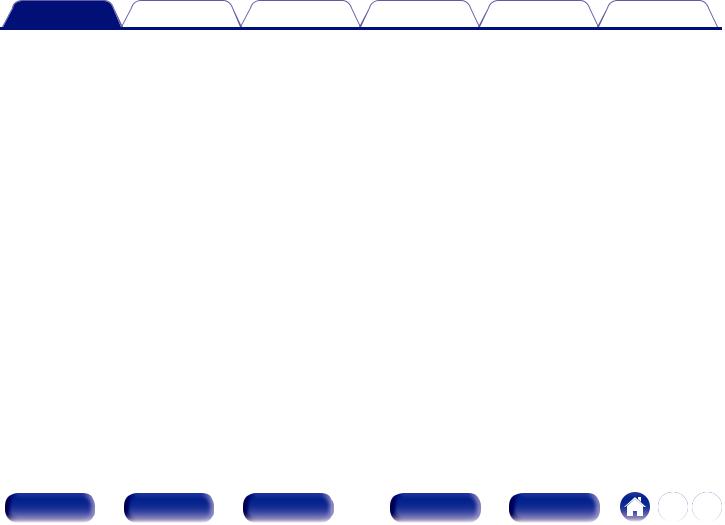
Contents |
Connections |
Playback |
Settings |
Tips |
Appendix |
Selecting a sound mode |
145 |
|
|
Selecting a sound mode |
146 |
|
Direct playback |
147 |
|
Pure Direct playback |
147 |
|
Auto surround playback |
148 |
HDMI control function |
159 |
|
|
Setting procedure |
159 |
Smart Menu function |
160 |
|
Sleep timer function |
162 |
|
|
Using the sleep timer |
163 |
Smart select function |
164 |
|
|
Calling up the settings |
165 |
|
Changing the settings |
166 |
Panel lock function |
167 |
|
|
Disabling all key button operations |
167 |
|
Disabling all button operations except VOLUME |
167 |
|
Canceling the Panel lock function |
168 |
Remote lock function |
169 |
|
|
Disabling the sensor function of the remote control unit |
169 |
|
Enabling the remote sensor function |
169 |
|
Switches light illumination on/off |
170 |
Playback in ZONE2/ZONE3 (Separate room) |
171 |
|
|
Connecting ZONE |
171 |
|
Playback in ZONE2/ZONE3 |
177 |
Settings
Menu map |
179 |
||
|
Menu operations |
183 |
|
Audio |
184 |
||
|
Dialog Level Adjust |
184 |
|
|
Subwoofer Level Adjust |
184 |
|
|
Surround Parameter |
185 |
|
|
M-DAX |
189 |
|
|
Audio Delay |
190 |
|
|
Volume |
191 |
|
|
Audyssey® |
192 |
|
|
Graphic EQ |
195 |
|
Video |
197 |
||
|
Picture Adjust |
197 |
|
|
HDMI Setup |
199 |
|
|
Output Settings |
204 |
|
|
Component Video Out |
207 |
|
|
On Screen Display |
208 |
|
|
TV Format |
209 |
|
Inputs |
210 |
||
|
Input Assign |
210 |
|
|
Source Rename |
212 |
|
|
Hide Sources |
213 |
|
|
Source Level |
213 |
|
|
Input Select |
214 |
|
Front panel |
Display |
Rear panel |
4 |
Remote |
Index |
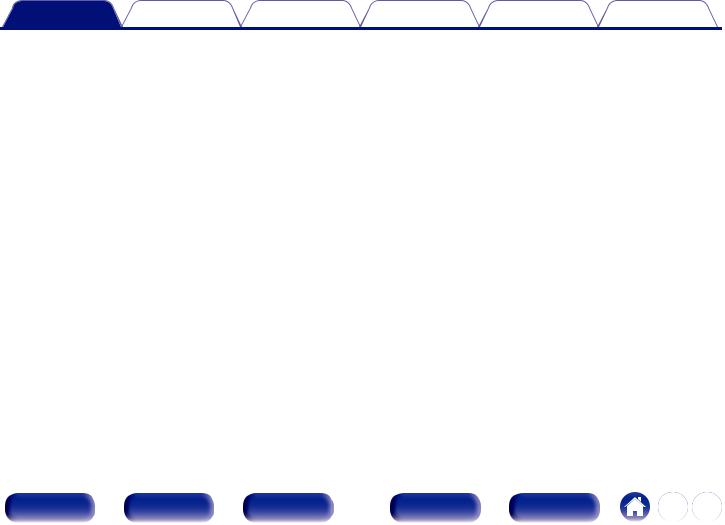
Contents |
Connections |
Playback |
Settings |
Tips |
Appendix |
Speakers |
215 |
|
Audyssey® Setup |
215 |
|
|
Procedure for speaker settings (Audyssey® Setup) |
217 |
|
Error messages |
223 |
|
Retrieving Audyssey® Setup settings |
225 |
Manual Setup |
226 |
|
|
Amp Assign |
226 |
|
Speaker Config. |
233 |
|
Distances |
238 |
|
Levels |
240 |
|
Crossovers |
241 |
|
Bass |
242 |
|
Front Speaker |
243 |
|
2ch Playback |
243 |
Network |
246 |
|
|
Information |
246 |
|
Connection |
246 |
|
Wi-Fi Setup |
247 |
|
Settings |
249 |
|
Network Control |
251 |
|
Friendly Name |
251 |
|
Diagnostics |
252 |
HEOS Account |
253 |
||
|
I have a HEOS Account |
253 |
|
|
Create Account |
253 |
|
|
Forgot Password |
253 |
|
|
Signed in As |
253 |
|
|
Change Location |
253 |
|
|
Change Password |
253 |
|
|
Delete Account |
253 |
|
|
Sign Out |
253 |
|
General |
254 |
|
|
|
Language |
254 |
|
|
ECO |
254 |
|
|
ZONE2 Setup / ZONE3 Setup |
257 |
|
|
Zone Rename |
259 |
|
|
Smart Select Names |
259 |
|
|
Trigger Out 1 / Trigger Out 2 |
260 |
|
|
Front Display |
260 |
|
|
Firmware |
262 |
|
|
Information |
265 |
|
|
Usage Data |
267 |
|
|
Setup Lock |
267 |
|
Front panel |
Display |
Rear panel |
5 |
Remote |
Index |
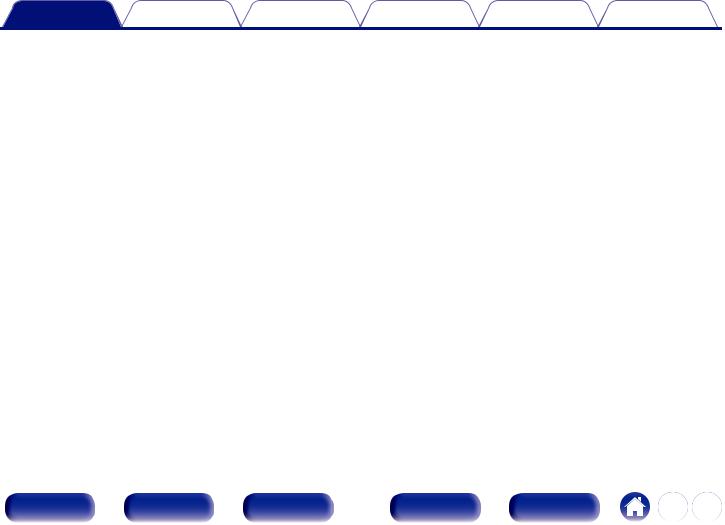
Contents |
Connections |
Playback |
Settings |
Tips |
Appendix |
Operating external devices with the remote control unit |
268 |
|
|
Registering preset codes |
269 |
|
Operating devices |
273 |
|
Checking registered preset codes |
276 |
|
Initializing registered preset codes |
276 |
|
Operating learning function |
277 |
|
Remembering remote control codes from other devices |
278 |
|
Delete saved remote control codes |
279 |
Setting the back light |
280 |
|
|
Disabling the backlight |
280 |
|
Turning the backlight on |
280 |
|
Specifying the zone used with the remote control unit |
281 |
Tips |
|
|
|
Tips |
283 |
|
Troubleshooting |
285 |
|
Resetting factory settings |
302 |
Resetting network settings |
303 |
|
Appendix
About HDMI |
304 |
|
Video conversion function |
307 |
|
Playing back a USB memory devices |
309 |
|
Playing back a Bluetooth device |
310 |
|
Playing back a file saved on a PC or NAS |
311 |
|
Playing back Internet Radio |
312 |
|
Personal memory plus function |
312 |
|
Last function memory |
312 |
|
Sound modes and channel output |
313 |
|
Sound modes and surround parameters |
315 |
|
Types of input signals, and corresponding sound modes |
319 |
|
Explanation of terms |
323 |
|
Trademark information |
332 |
|
Specifications |
335 |
|
Index |
341 |
|
License |
344 |
|
Front panel |
Display |
Rear panel |
6 |
Remote |
Index |
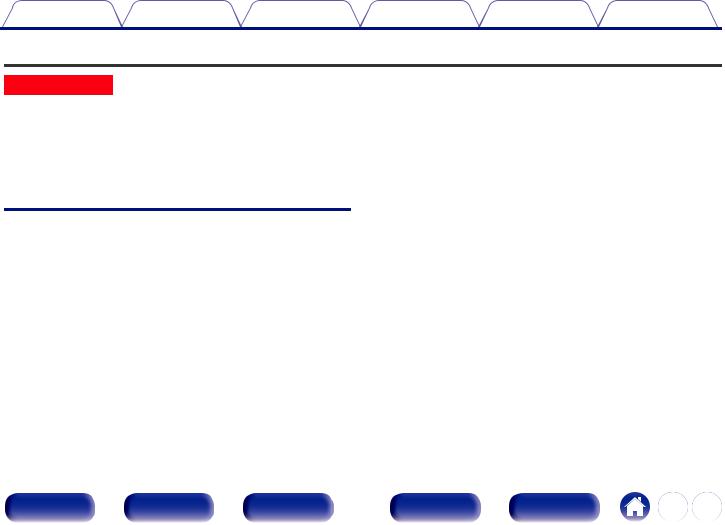
Contents |
Connections |
Playback |
Settings |
Tips |
Appendix |
Upgrade
Upgrade (Auro-3D)
The text marked with this symbol that will enable after the upgrade of the Auro-3D.
You can experience the best performance of Auro-3D if you install Front Height and Surround Height in addition to standard 5.1-channel. The “Setup Assistant” will lead you to this setting.
You can use Rear Height speakers from a Dolby Atmos Enabled speaker setup instead of Surround Height speakers for Auro-3D playback.
This unit also can play Auro-3D using standard 5.1-channel and Front Height speakers. If you install any height speakers instead of Surround Height speakers and Rear Height speakers, you can set the speaker configuration in setup menu.
Auro-3D
Features |
|
High quality sound |
11 |
Connecting speakers |
|
Speaker installation |
37, 40 |
Layout including height speakers and ceiling speakers |
43 |
Speaker configuration and “Amp Assign” settings |
49 |
Auro-3D 9.1/10.1-channel system |
61, 67 |
Selecting a sound mode |
|
Description of sound mode types Auro-3D sound mode |
151 |
Sound mode that can be selected for each input signal |
157 |
Audio |
|
Auro-Matic 3D Preset |
187 |
Auro-Matic 3D Strength |
188 |
Manual Setup |
|
Amp Assign |
229, 232 |
Speaker Config. |
237, 238 |
Appendix |
|
Sound modes and channel output |
314 |
Sound mode and surround parameters |
317 |
Types of input signals, and corresponding sound modes |
321 |
Explanation of terms |
324 |
Trademark information |
334 |
Front panel |
Display |
Rear panel |
7 |
Remote |
Index |
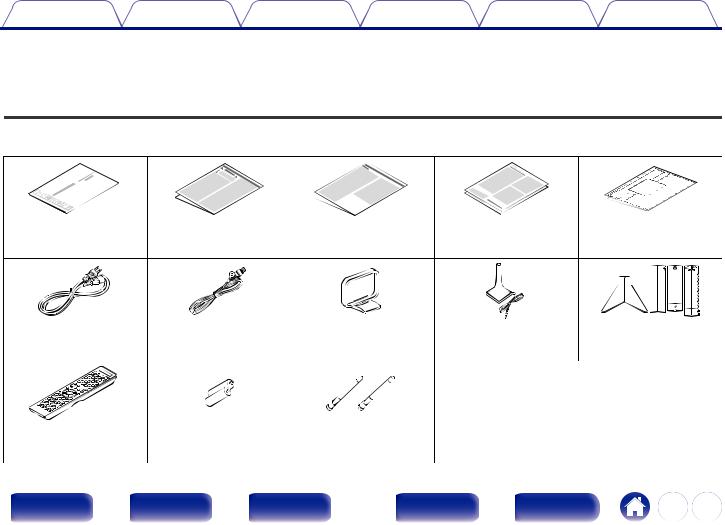
Contents |
Connections |
Playback |
Settings |
Tips |
Appendix |
Thank you for purchasing this Marantz product.
To ensure proper operation, please read this owner’s manual carefully before using the product.
After reading this manual, be sure to keep it for future reference.
Accessories
Check that the following parts are supplied with the product.
Quick Start Guide |
Safety Instructions |
Notes on radio |
Warranty |
Cable labels |
|
|
|
(for USA/for CANADA) |
|
Power cord |
FM indoor antenna |
AM loop antenna |
Sound calibration |
Sound calibration |
|
|
|
microphone |
microphone stand |
Remote control unit |
R03/AAA batteries |
External antennas for |
|
|
Bluetooth/wireless |
|
|
connectivity |
 Front panel
Front panel 
 Display
Display 
 Rear panel
Rear panel  8
8  Remote
Remote 
 Index
Index
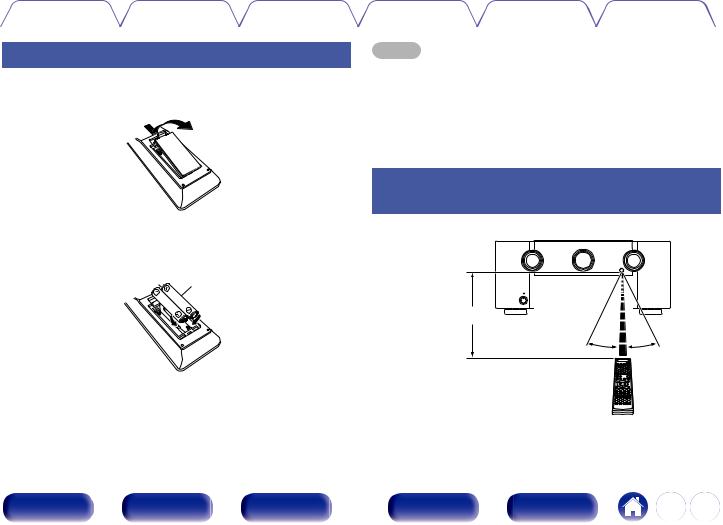
Contents |
Connections |
Playback |
Settings |
Tips |
Appendix |
|
|
|
|
|
|
Inserting the batteries
1Remove the rear lid in the direction of the arrow and remove it.
2Insert two batteries correctly into the battery compartment as indicated.
Batteries
NOTE
0 To prevent damage or leakage of battery fluid:
0Do not use a new battery together with an old one.
0Do not use two different types of batteries.
0Remove the batteries from the remote control unit if it will not be in use for long periods.
0If the battery fluid should leak, carefully wipe the fluid off the inside of the battery compartment and insert new batteries.
Operating range of the remote control unit
Point the remote control unit at the remote sensor when operating it.
Approx. 23 ft/7 m
30° 30°
3Put the rear cover back on.
Front panel |
Display |
Rear panel |
9 |
Remote |
Index |
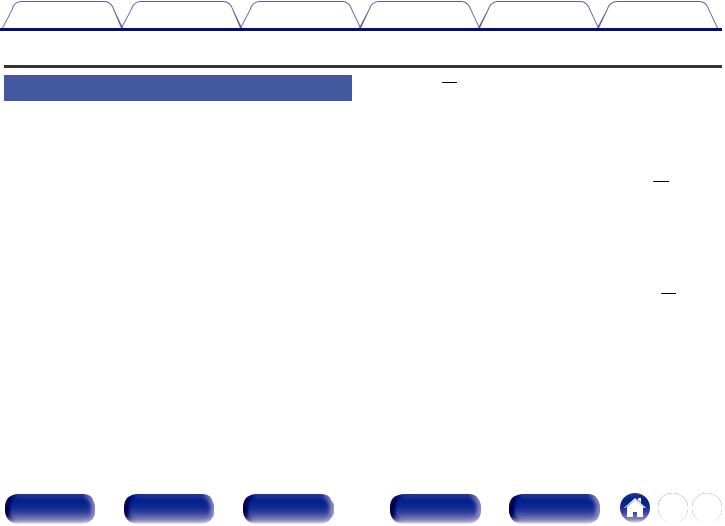
Contents |
Connections |
Playback |
Settings |
Tips |
Appendix |
Features
High quality sound
0With discrete circuit technology, the power amplifier provides identical quality for all 9-channels (165 Watts x 9-channels)
For optimum realism and stunning dynamic range, the power amplifier section features discrete power devices (not integrated circuitry).
By using high current, high power discrete power devices, the amplifier is able to easily drive high quality speakers.
0Current feedback amplifier
This unit uses a high-speed current feedback amplifier circuit for its preamplifier so that signals from a Blu-ray Disc player and other equipment that support high-definition audio formats can be amplified with high fidelity. The high-speed current feedback amplifier also reproduces a natural sound space.
0 Dolby Atmos (v p. 324)
This unit is equipped with a decoder that supports Dolby Atmos audio format. The placement or movement of sound is accurately reproduced by the addition of overhead speakers, enabling you to experience an incredibly natural and realistic surround sound field.
0 DTS:X (v p. 327)
This unit is equipped with the DTS:X decoder technology. DTS:X brings the home theater experience to new heights with its immersive object based audio technology which removes the bounds of channels. The flexibility of objects allows for sound to be scaled large or small and moved around the room with greater accuracy than ever before leading to a richer immersive audio experience.
0Audyssey LFC™ (Low Frequency Containment) (v p. 194)
Audyssey LFC™ solves the problem of low frequency sounds disturbing people in neighboring rooms or apartments. Audyssey LFC™ dynamically monitors the audio content and removes the low frequencies that pass through walls, floors and ceilings. It then applies psychoacoustic processing to restore the perception of low bass for listeners in the room. The result is great sound that no longer disturbs the neighbors.
0Discrete subwoofers and Audyssey Sub EQ HT™ (v p. 216)
The unit has two subwoofer output capability and can adjust the level and delay for each subwoofer individually.
Audyssey Sub EQ HT™ makes the integration seamless by first compensating for any level and delay differences between the two
subwoofers and then applying Audyssey MultEQ® XT32 to both subwoofers together for improved deep bass response and detail.
Front panel |
Display |
Rear panel |
10 |
Remote |
Index |
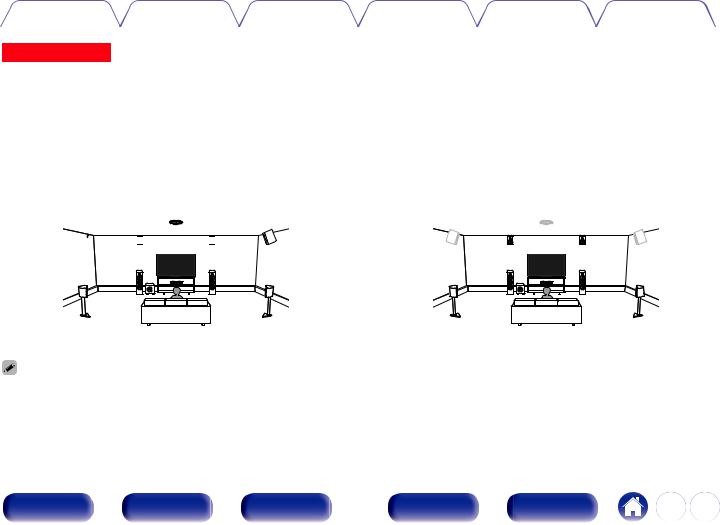
Contents |
Connections |
Playback |
Settings |
Tips |
Appendix |
|
|
|
|
|
|
Upgrade (Auro-3D)
0 Auro-3D
This unit is equipped with an Auro-3D decoder.
With Auro-3D, Front Height (FHL + FHR), Surround Height (SHL + SHR) and Top Surround (TS/optional) are added to a conventional 5.1-channel system to achieve a natural and realistic sound field that is three-dimensional and fully immersive.
After performing the Auro-3D upgrade you will be able to fully enjoy Auro-3D playback if you properly place the speakers for Auro-3D.
2 Auro-3D playback |
2Dolby Atmos playback |
TS

 FHL FHR
FHL FHR  SHL
SHL
|
FL |
FR |
SL |
SW |
C |
SHR |
SHL |
SR |
SL |
|
TS |
FHL |
FHR |
|
SHR |
FL |
|
FR |
SW |
C |
SR |
0Auro-3D does not support a Dolby Atmos configuration using Top Front, Top Middle, Top Rear, or any Dolby Atmos Enabled speakers.
If you are using these speakers and want to take full advantage of the Auro-3D Upgrade, you need to relocate them to Front Height and Surround Height speaker locations as shown above.
But it is possible to support both an Auro-3D and Dolby Atmos by adding Front Height and Rear Height speakers* to a 5.1 configuration. zFor an optimum Auro-3D experience Surround Height speakers are strongly recommended.
Front panel |
Display |
Rear panel |
11 |
Remote |
Index |
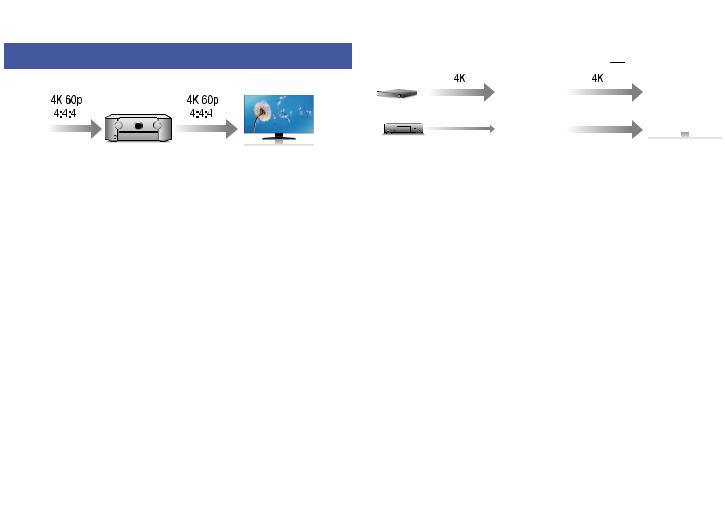
Contents |
Connections |
Playback |
Settings |
Tips |
Appendix |
High performance
04K 60Hz input/output supported
When 4K Ultra HD (High Definition) is used, an input/output speed of 60 frames per second (60p) is achieved for video signals. When connected to 4K Ultra HD and 60p video signal input compatible TV, you can enjoy the sense of realism only available from high-definition images, even when viewing fast-moving video.
This unit also supports image processing for 4K 60p, 4:4:4 and 24-bit videos. By processing the video at the original resolution, this unit lets you enjoy flawless, high-definition picture quality.
0HDCP 2.2
This unit is compatible with HDCP 2.2 copyright protection standard.
0Digital video processor upscales analog video signals (SD resolution) to HD (720p/1080p) and 4K (v p. 206)
|
Up to 1080p |
|
|
|
|
|
4K |
|
|
|
|
|
|
Up scaling |
|
|
|
|
|
|
|
||
|
|
|
|
|
|
||
|
|
|
|
|
|
|
|
This unit is equipped with a 4K video upscaling function that allows analog video or SD (Standard Definition) video to be output via HDMI at 4K (3840 × 2160 pixels) resolution. This function enables the device to be connected to a TV using a single HDMI cable, and produces high definition images for any video source.
0Equipped with HDMI ZONE2 output (v p. 171)
The ZONE2 multi-room output includes an HDMI output that lets you enjoy a different A/V source in that room, with another program playing in the main room.
Front panel |
Display |
Rear panel |
12 |
Remote |
Index |

Contents |
Connections |
Playback |
Settings |
Tips |
Appendix |
0HDMI connections enable connection to various digital AV devices (8 inputs, 3 outputs)
8  3
3
In Out
For connection to a broad range of digital sources, this unit features 8 HDMI inputs, including 1 on the front panel that lets you quickly and conveniently connect a camcorder, game console or other HDMIequipped device. There are dual HDMI outputs for the main room, and a third HDMI output for ZONE2.
0The device is equipped with a AirPlay® function in addition to network functions such as Internet radio etc. (v p. 133)
You can enjoy a wide variety of content, including listening to Internet Radio, playing audio files stored on your PC.
This unit also supports Apple AirPlay which lets you stream your music library from an iPhone®, iPad®, iPod touch® or iTunes®.
0Playback of DSD and FLAC files via USB and networks
This unit supports the playback of high resolution audio formats such as DSD (5.6 MHz) and FLAC 192 kHz files. It provides high quality playback of high resolution files.
Front panel |
Display |
Rear panel |
13 |
Remote |
Index |
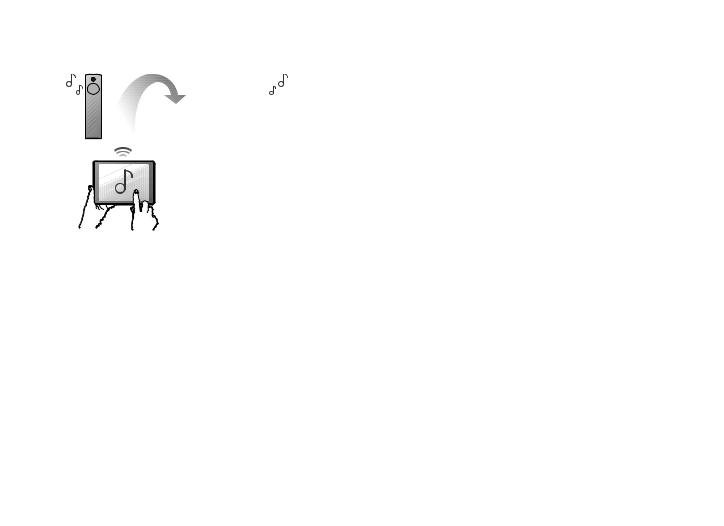
Contents |
Connections |
|
Playback |
Settings |
Tips |
Appendix |
|||||||||
|
|
|
|
|
|
|
|||||||||
0 Wireless connection with Bluetooth devices can be carried out |
0 Multi-Room audio (v p. 144) |
|
|||||||||||||
easily (v p. 102) |
|
|
|
|
|
|
|
MAIN ZONE |
|
|
ZONE2 / ZONE3 |
||||
|
|
|
|
|
|
|
|
|
|
|
|
|
|
||
|
|
|
|
|
|
|
|
|
|
|
|
|
|
|
|
|
|
|
|
|
|
|
|
|
|
|
|
|
|
|
|
|
|
|
|
|
|
|
|
|
|
|
|
|
|
|
|
|
|
|
|
|
|
|
|
|
|
|
|
|
|
|
|
|
|
|
|
|
|
|
|
|
|
|
|
|
|
|
|
|
|
|
|
|
|
|
|
|
|
|
|
|
|
|
|
You can enjoy music simply by connecting wirelessly with your smartphone, tablet, PC, etc.
You can select and play back the respective inputs in MAIN ZONE, ZONE2 and ZONE3.
In addition, when the All Zone Stereo function is used, the music being played back in MAIN ZONE can be enjoyed in all the zones at the same time. This is useful when you want to let the BGM propagate throughout the whole house.
0Energy-saving design
This unit is equipped with an ECO Mode function that allows you to enjoy music and movies while reducing the power consumption during use, and also an auto-standby function that automatically turns off the power supply when the unit is not in use. This helps reduce unnecessary power use.
Front panel |
Display |
Rear panel |
14 |
Remote |
Index |
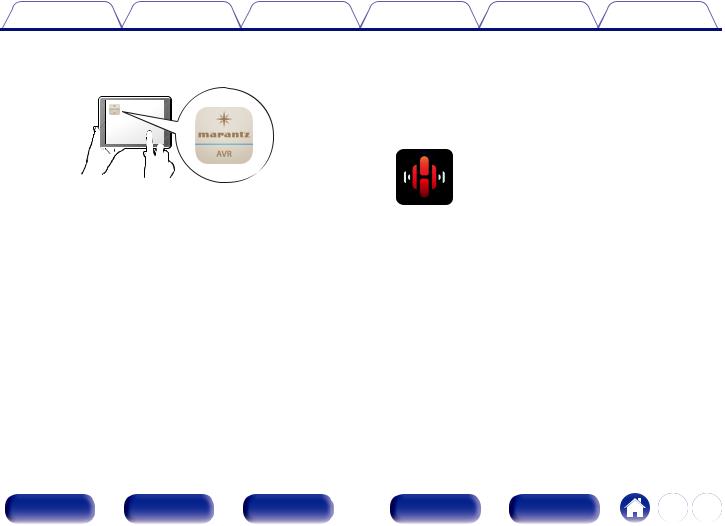
Contents |
Connections |
Playback |
Settings |
Tips |
Appendix |
0Compatible with the “Marantz 2016 AVR Remote App”z for performing basic operations of the unit with an iPad, iPhone or Android™ devices (Google, Amazon Kindle Fire)
Along with many new features, the graphics and user interface have been completely overhauled. The new app gives you full control of the AVR as well as access to its setup menu for detailed adjustments from your phones or tablets. “Marantz 2016 AVR Remote App” also gives you quick access to the receiver's status display, option menus, Marantz Blu-ray Disc player control, and online owner's manual for your convenience.
zDownload the appropriate “Marantz 2016 AVR Remote App” for your iOS or Android devices. This unit needs to be connected to the same LAN or Wi-Fi (wireless LAN) network that the iPhone or iPod touch is connected to.
0HEOS provides streaming music from your favorite online music sources
HEOS wireless multi-room sound system that enables you to enjoy your favorite music anywhere and everywhere around your home. By utilizing your existing home network and the HEOS App (available for iOS, Android and Amazon devices), you can explore, browse, and play music from your own music library or from many online streaming music services.
When multiple HEOS devices are connected to the same network, HEOS devices can be grouped to play back the same music on all devices simultaneously, or different music can be played on each separate HEOS device.
Front panel |
Display |
Rear panel |
15 |
Remote |
Index |
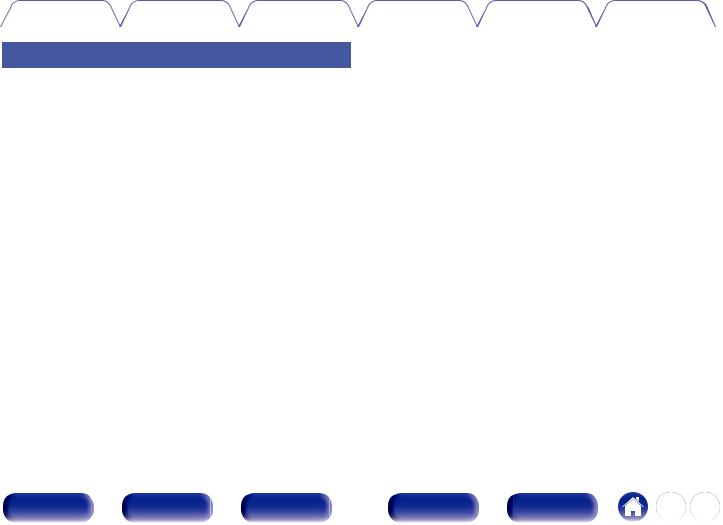
Contents |
Connections |
Playback |
Settings |
Tips |
Appendix |
|
|
|
|
|
|
Easy operation
0“Setup Assistant” provides easy-to-follow setup instructions
First select the language when prompted. Then simply follow the instructions displayed on the TV screen to set up the speakers, network, etc.
0Easy to use Graphical User Interface
This unit is equipped with a Graphical User Interface for improved operability.
Front panel |
Display |
Rear panel |
16 |
Remote |
Index |
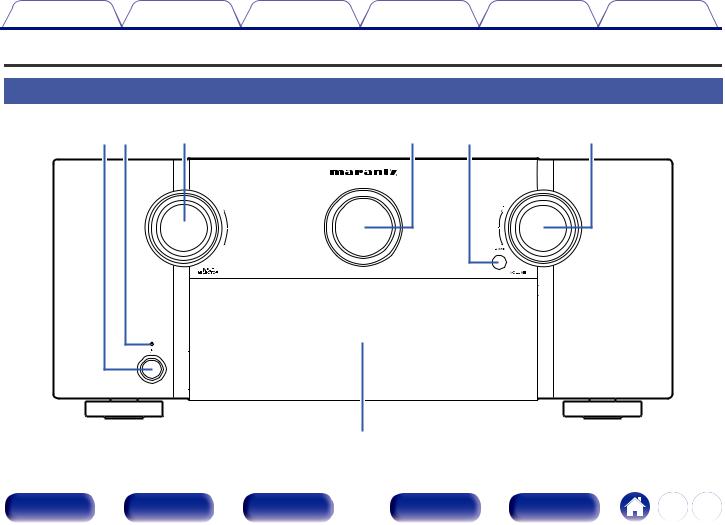
Contents |
Connections |
Playback |
Settings |
Tips |
Appendix |
Part names and functions
Front panel
q w |
e |
r |
t |
y |
|
|
|
u |
|
|
For details, see the next page. |
|
|
|
|
|
Front panel |
Display |
Rear panel |
17 |
Remote |
Index |
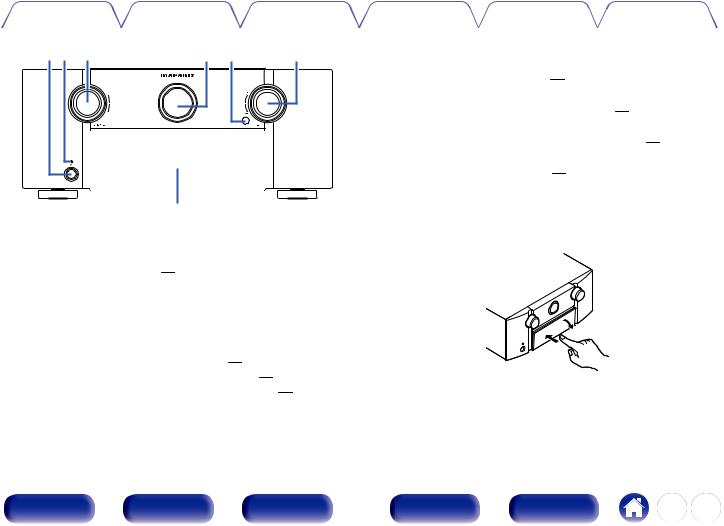
Contents |
Connections |
Playback |
Settings |
Tips |
Appendix |
|
|
|
|
|
|
qw e |
r t |
y |
u
A Power operation button (X)
Used to turn the power of the MAIN ZONE (room where this unit is located) on/off (standby). (v p. 96)
B Power indicator
This is lit as follows according to the power status:
0Off: Power on
0Red: Normal standby
0Orange:
0 When “HDMI Control” is set to “On” (v p. 201)
0 When “HDMI Pass Through” is set to “On” (v p. 199)
0 When “Network Control” is set to “Always On” (v p. 251)
C INPUT SELECTOR knob
This selects the input source. (v p. 96)
D Main display
This displays various pieces of information. (v p. 22)
E Remote control sensor
This receives signals from the remote control unit. (v p. 9)
F VOLUME knob
This adjusts the volume level. (v p. 97)
GDoor
When you are using buttons and/or connectors behind the door, press the bottom of the door to open it. Be careful not to catch your fingers when closing the door.
Front panel |
Display |
Rear panel |
18 |
Remote |
Index |
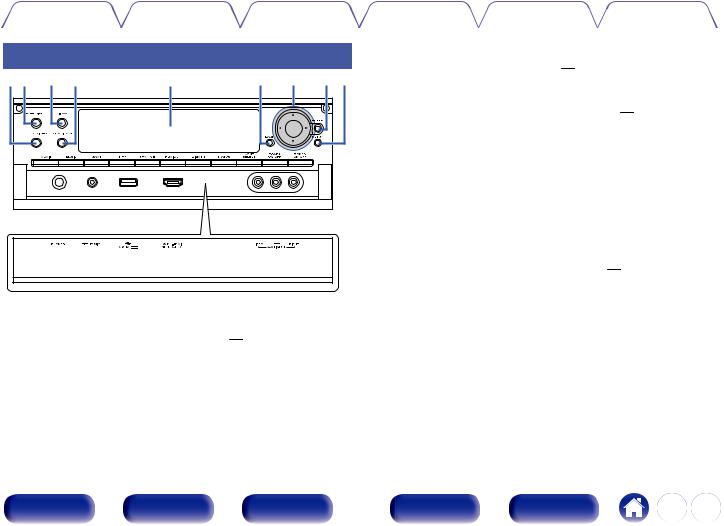
Contents |
Connections |
Playback |
Settings |
Tips |
Appendix |
|
|
|
|
|
|
With the door open
qw e r |
t |
y u i o |
A DYNAMIC EQ button
This switches the Dynamic EQ settings. (v p. 193)
B PURE DIRECT button/indicator
This switches the sound mode between Direct, Pure Direct and Auto. (v p. 147 – 148)
This lights when the Pure Direct mode is selected as the sound mode.
C M-DAX button/indicator
This enables the M-DAX mode. (v p. 189) This lights when the M-DAX mode is selected.
D Dynamic Volume button (DYNAMIC VOL)
This switches the Dynamic Volume settings. (v p. 194)
E Sub display
This displays various pieces of information. (v p. 24)
F BACK button
This returns to the previous screen.
G Cursor buttons (uio p)
These select items.
H ENTER button
This determines the selection.
I SETUP button
This displays the menu on the TV screen. (v p. 183)
Front panel |
Display |
Rear panel |
19 |
Remote |
Index |
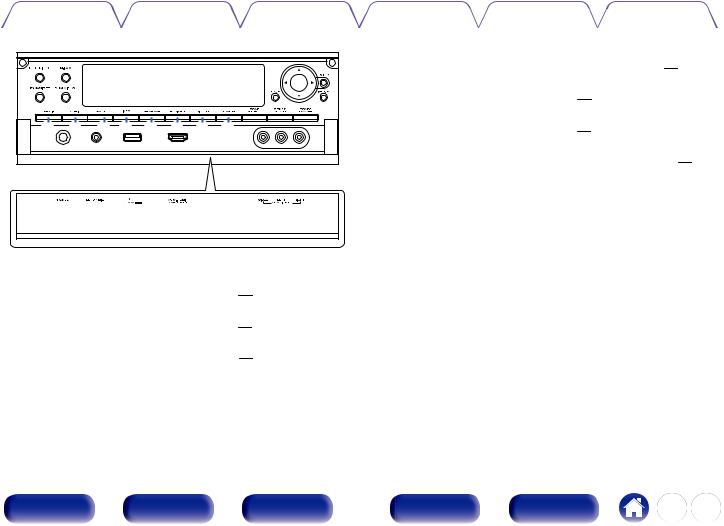
Contents |
Connections |
Playback |
Settings |
Tips |
Appendix |
|
|
|
|
|
|
Q0Q1Q2Q3Q4Q5Q6Q7 |
J MOVIE button
This switches the sound mode to “Movie”. (v p. 146)
K MUSIC button
This switches the sound mode to “Music”. (v p. 146)
L GAME button
This switches the sound mode to “Game”. (v p. 146)
M Information button (INFO)
This displays the status information on the TV screen. (v p. 266)
N Speaker A/B switching button (SPKR A/B)
This sets the front speakers to use. (v p. 243)
O HDMI OUT button
This sets the HDMI monitor output. (v p. 199)
P DIMMER button
Each press of this switches the brightness of the display. (v p. 260)
Q STATUS button
Each press of this switches the status information that is shown on the display.
Front panel |
Display |
Rear panel |
20 |
Remote |
Index |
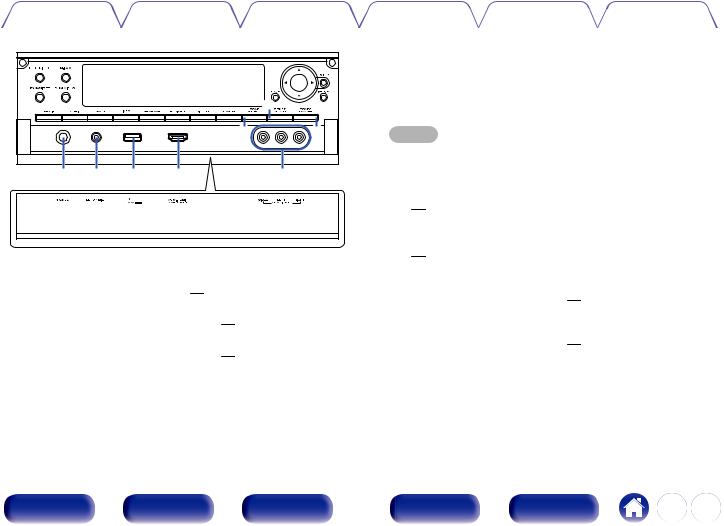
Contents |
Connections |
Playback |
Settings |
Tips |
Appendix |
|
|
|
|
|
|
|
Q9 |
|
|
Q8 |
W0 |
W1 W2 W3 |
W4 |
W5 |
R ZONE SELECT button
These switch the zone (MAIN ZONE, ZONE2, ZONE3) that is operated through the remote control unit. (v p. 177, 183)
S ZONE2 ON/OFF button
This turns the power of ZONE2 on/off. (v p. 177)
T ZONE3 ON/OFF button
This turns the power of ZONE3 on/off. (v p. 177)
U Headphones jack (PHONES)
This is used to connect headphones.
When the headphones are plugged into this jack, audio will no longer be output from the connected speakers or from the PRE OUT connectors.
NOTE
0To prevent hearing loss, do not raise the volume level excessively when using headphones.
V SETUP MIC jack
This is used to connect the supplied Sound calibration microphone. (v p. 218)
WUSB port (T)
This is used to connect USB storages (such as USB memory devices). (v p. 87)
X AUX1-HDMI connector
This is used to connect HDMI output compatible devices such as video camcorders and game consoles. (v p. 84)
Y AUX1 INPUT connectors
Used to connect analog output compatible devices such as video camcorders and game consoles. (v p. 84)
Front panel |
Display |
Rear panel |
21 |
Remote |
Index |
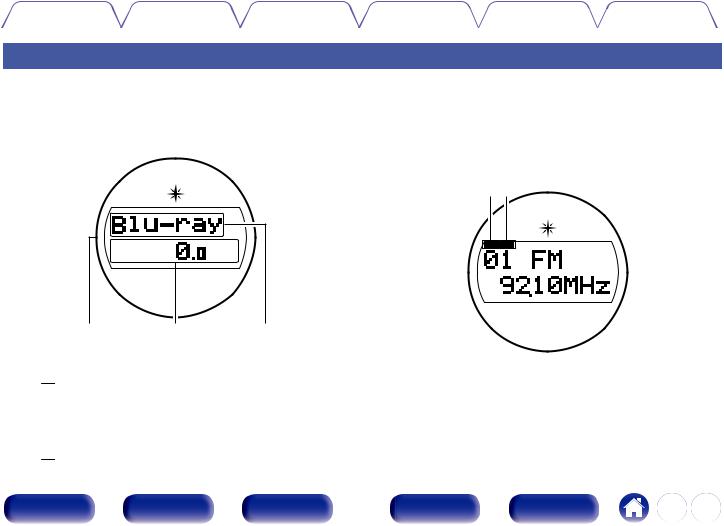
Contents |
Connections |
Playback |
Settings |
Tips |
Appendix |
|
|
|
|
|
|
Display
o Main display
The input source name, sound mode, setting values and other information are displayed here.
n Standard display |
n Tuner display |
q |
w |
e |
A Light illumination
When the power to this device is switched on, the surrounding area is lit blue. The settings can be changed so the light does not switch on. (v p. 170)
B Volume indicator
C Input source indicator
The currently selected input source name is displayed.
If the input source name has been changed using “Source Rename” in the menu, the input source name after the change is displayed.
(v p. 212)
These light up according to the reception conditions when the input source is set to “HD Radio”.
r t
D Lights up when the broadcast is properly tuned in.
E In the FM mode, this lights up when receiving stereo broadcasts.
Front panel |
Display |
Rear panel |
22 |
Remote |
Index |
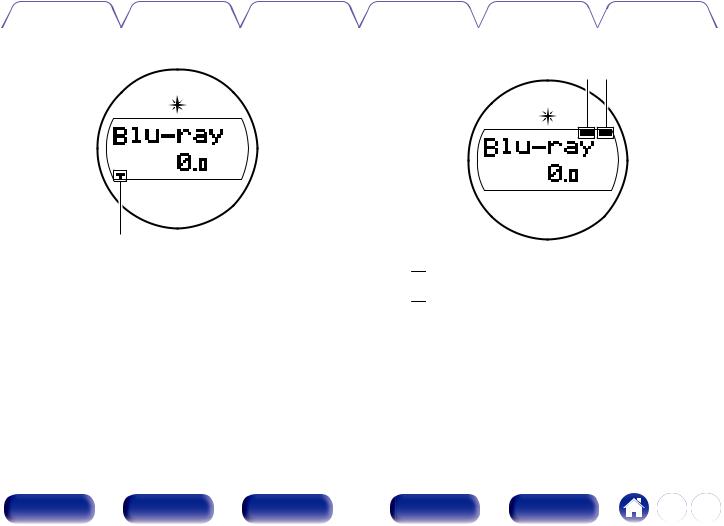
Contents |
Connections |
Playback |
Settings |
Tips |
Appendix |
|
|
|
|
||
n Sleep timer indicator |
|
n ZONE2/ZONE3 power on display |
|
||
|
|
|
|
u i |
|
y
F This lights when the sleep mode is selected. (v p. 162)
G This lights up when ZONE2 (separate room) power is turned on. (v p. 177)
H This lights up when ZONE3 (separate room) power is turned on. (v p. 177)
Front panel |
Display |
Rear panel |
23 |
Remote |
Index |
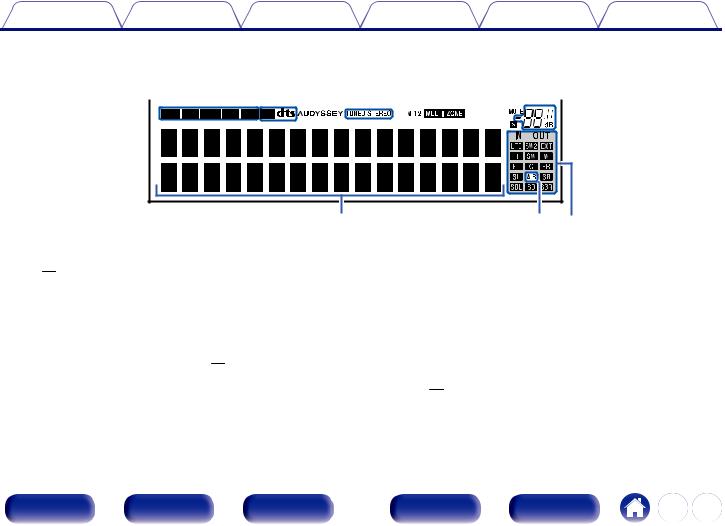
Contents |
Connections |
Playback |
Settings |
Tips |
Appendix |
o Sub display
|
q |
w e r t y |
u i o |
||||||||||
|
|
|
|
|
|
|
|
|
|
|
|
|
|
|
|
|
|
|
|
|
|
|
|
|
|
|
|
|
|
|
|
|
|
|
|
|
|
|
|
|
|
Q0
A Input signal indicators
The respective indicator will light corresponding to the input signal. (v p. 214)
B Decoder indicators
These light when Dolby or DTS signals are input or when the Dolby or DTS decoder is running.
C Audyssey® indicator
This lights when “MultEQ® XT32”, “Dynamic EQ”, “Dynamic Volume” or “Audyssey LFCTM” has been set up. (v p. 192)
Q1 Q2 |
D Tuner reception mode indicators
These light up according to the reception conditions when the input source is set to “HD Radio”.
TUNED: Lights up when the broadcast is properly tuned in. STEREO: Lights up when receiving FM stereo broadcasts.
E Monitor output indicator
These light according to the HDMI monitor output setting. When set to “Auto(Dual)”, the indicators light according to connection status.
F MULTI ZONE indicator
This lights up when ZONE2 or ZONE3 (separate room) power is turned on. (v p. 177)
Front panel |
Display |
Rear panel |
24 |
Remote |
Index |
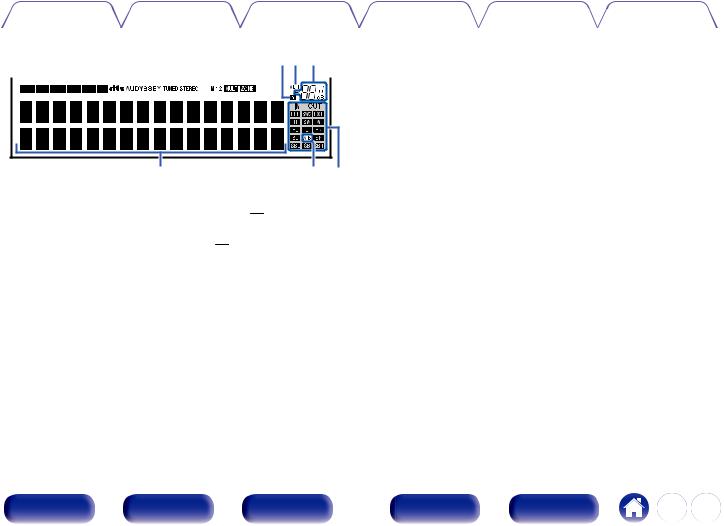
|
Contents |
Connections |
Playback |
Settings |
Tips |
Appendix |
|
|
|
|
|
|
|
|
|
|
|
|
ui o |
L Input/output signal channel indicators |
|
|
|
|
|
|
The channel for input/output signals is displayed according to the |
||||
|
|
|
|
setting configured for “Channel Indicators”. (v p. 261) |
|||
|
|
|
|
||||
|
|
|
|
|
|
|
|
|
0 |
When “Channel Indicators” is set to “Output” (Default) |
|
|
These light when audio signals are being output from the speakers. |
|
0 |
When “Channel Indicators” is set to “Input” |
|
|
These light corresponding to the channels that include the input |
|
|
signals. |
Q0 |
Q1Q2 |
When playing HD Audio sources, the Aindicator lights when a |
signal from an extension channel (a channel other than the front, |
||
G Sleep timer indicator |
|
center, surround, surround back, front height, front wide or LFE |
|
channel) is input. |
|
This lights when the sleep mode is selected. (v p. 162) |
|
|
|
|
H MUTE indicator
This blinks while the sound is muted. (v p. 97)
I Volume indicator
J Information display
The input source name, sound mode, setting values and other information are displayed here.
K Front speaker indicator
This lights according to the setting of the front A and B speakers.
Front panel |
Display |
Rear panel |
25 |
Remote |
Index |
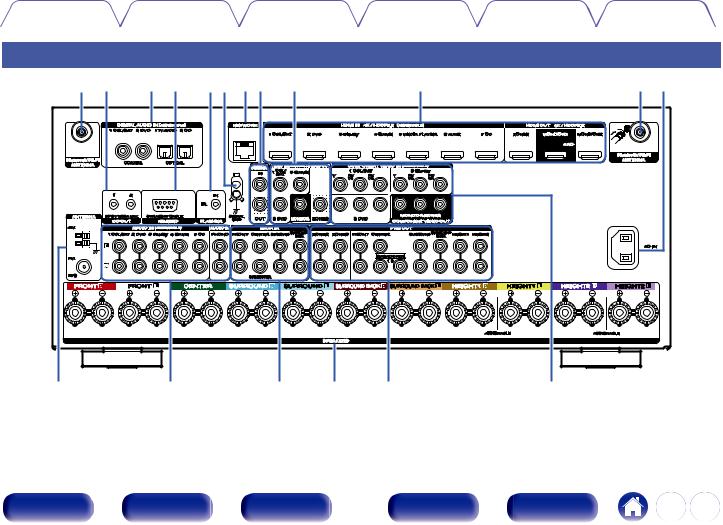
Contents |
Connections |
Playback |
Settings |
Tips |
Appendix |
|
|
|
|
|
|
Rear panel
q w e r ty ui o |
Q0 |
q Q1 |
Q2 |
Q3 |
Q4 |
Q5 |
Q6 |
Q7 |
For details, see the next page.
Front panel |
Display |
Rear panel |
26 |
Remote |
Index |
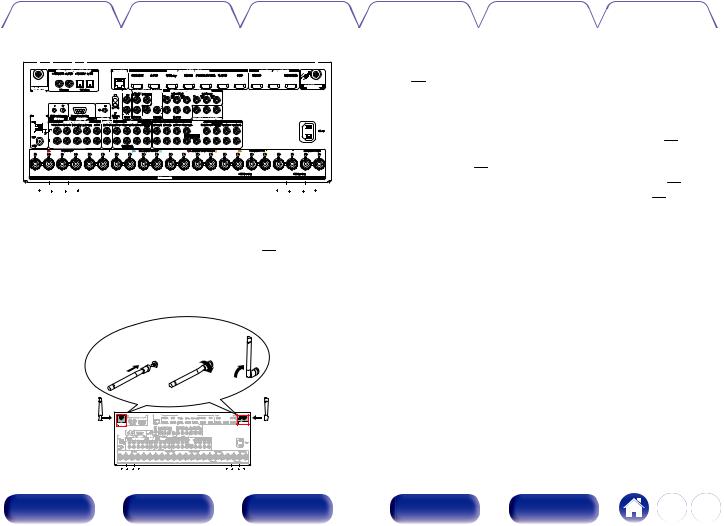
Contents |
Connections |
Playback |
Settings |
Tips |
Appendix |
|
|
|
|
|
|
|
qw er |
|
|
|
|
|
|
|
|
|
|
|
|
|
|
|
|
|
|
|
|
|
|
|
|
|
|
|
|
|
|
|
|
|
|
|
|
|
q |
||||||||||||||||||||||||||||||||
|
|
|
|
|
|
|
|
|
|
|
|
|
|
|
|
|
|
|
|
|
|
|
|
|
|
|
|
|
|
|
|
|
|
|
|
|
|
|
|
|
|
|
|
|
|
|
|
|
|
|
|
|
|
|
|
|
|
|
|
|
|
|
|
|
|
|
|
|
|
|
|
|
|
|
|
|
|
|
|
|
|
|
|
|
|
|
|
|
|
|
|
|
|
|
|
|
|
|
|
|
|
|
|
|
|
|
|
|
|
|
|
|
|
|
|
|
|
|
|
|
|
|
|
|
|
|
|
|
|
|
|
|
|
|
|
|
|
|
|
|
|
|
|
|
|
|
|
|
|
|
|
|
|
|
|
|
|
|
|
|
|
|
|
|
|
|
|
|
|
|
|
|
|
|
|
|
|
|
|
|
|
|
|
|
|
|
|
|
|
|
|
|
|
|
|
|
|
|
|
|
|
|
|
|
|
|
|
|
|
|
|
|
|
|
|
|
|
|
|
|
|
|
|
|
|
|
|
|
|
|
|
|
|
|
|
|
|
|
|
|
|
|
|
|
|
|
|
|
|
|
|
|
|
|
|
|
|
|
|
|
|
|
|
|
|
|
|
|
|
|
|
|
|
|
|
|
|
|
|
|
|
|
|
|
|
|
|
|
|
|
|
|
|
|
|
|
|
|
|
|
|
|
|
|
|
|
|
|
|
|
|
|
|
|
|
|
|
|
|
|
|
|
|
|
|
|
|
|
|
|
|
|
|
|
|
|
|
|
|
|
|
|
|
|
|
|
|
|
|
|
|
|
|
|
|
|
|
|
|
|
|
|
|
|
|
|
|
|
|
|
|
|
|
|
|
|
|
|
|
|
|
|
|
|
|
|
|
|
|
|
|
|
|
|
|
|
|
|
|
|
|
|
|
|
|
|
|
|
|
|
|
|
|
|
|
|
|
|
|
|
|
|
|
|
|
|
|
|
|
|
|
|
|
|
|
|
|
|
|
|
|
|
|
|
|
|
|
|
|
|
|
|
|
|
|
|
|
|
|
|
|
|
|
|
|
|
|
|
|
|
|
|
|
|
|
|
|
|
|
|
|
|
|
|
|
|
|
|
|
|
|
|
|
|
|
|
|
|
|
|
|
|
|
|
|
|
|
|
|
|
|
|
|
|
|
|
|
|
|
|
|
|
|
|
|
|
|
|
|
|
|
|
|
|
|
|
|
|
|
|
|
|
|
|
|
|
|
|
|
|
|
|
|
|
|
|
|
|
|
|
|
|
|
|
|
|
|
|
|
|
|
|
|
|
|
|
|
|
|
|
|
|
|
|
|
|
|
|
|
|
|
|
|
|
|
|
|
|
|
|
|
|
|
|
|
|
|
|
|
|
|
|
|
|
|
|
|
|
|
|
|
|
|
|
|
|
|
|
|
|
|
|
|
|
|
|
|
|
|
|
|
|
|
|
|
|
|
|
|
|
|
|
|
|
|
|
|
|
|
|
|
|
|
|
|
|
|
|
|
|
|
|
|
|
|
|
|
|
|
|
|
|
|
|
|
|
|
|
|
|
|
|
|
|
|
|
|
|
|
|
|
|
|
|
|
|
|
|
|
|
|
|
|
|
|
|
|
|
|
|
|
|
|
|
|
|
|
|
|
|
|
|
|
|
|
|
|
|
|
|
|
|
|
|
|
|
|
|
|
|
|
|
|
|
|
|
|
|
|
|
|
|
|
|
|
|
|
|
|
|
|
|
|
|
|
|
|
|
|
|
|
|
|
|
|
|
|
|
|
|
|
|
|
|
|
|
|
|
|
|
|
|
|
|
|
|
|
|
|
|
|
|
|
|
|
|
|
|
|
|
|
|
|
|
|
|
|
|
|
|
|
|
|
|
|
|
|
|
|
|
|
|
|
|
|
|
|
|
|
|
|
|
|
|
|
|
|
|
|
|
|
|
|
|
|
|
|
|
|
|
|
|
|
|
|
|
|
|
|
|
|
|
|
|
|
|
|
|
|
|
|
|
|
|
|
|
|
|
|
|
|
|
|
|
|
|
|
|
|
|
|
|
|
|
|
|
|
|
|
|
|
|
|
|
|
|
|
|
|
|
|
|
|
|
|
|
|
|
|
|
|
|
|
|
|
|
|
|
|
|
|
|
|
|
|
|
|
|
|
|
|
|
|
|
|
|
|
|
|
|
|
|
|
|
|
|
|
|
|
|
|
|
|
|
|
|
|
|
|
|
|
|
|
|
|
|
|
|
|
|
|
|
|
|
|
|
|
|
|
|
|
|
|
|
|
|
|
|
|
|
|
|
|
|
|
|
|
|
|
|
|
|
|
|
|
|
|
|
|
|
|
|
|
|
|
|
|
|
|
|
|
|
|
|
|
|
|
|
|
|
|
|
|
|
|
|
|
|
|
|
|
|
|
|
|
|
|
|
|
|
|
|
|
|
|
|
|
|
|
|
|
|
|
|
|
|
|
|
|
|
|
|
|
|
|
|
|
|
|
|
|
|
|
|
|
|
|
|
|
|
|
|
|
|
|
|
|
|
|
|
|
|
|
|
|
|
|
|
|
|
|
|
|
|
|
|
|
|
|
|
|
A Bluetooth/wireless LAN antenna connectors
Used to connect the included external antennas for Bluetooth/wireless connectivity when connecting to a network via wireless LAN, or when connecting to a handheld device via Bluetooth. (v p. 91)
A Place the external antennas for Bluetooth/wireless connectivity evenly over the screw terminal of rear.
B Turn clockwise until the antennas is fully connected. C Rotate the antenna upwards for best reception.
B DC OUT jacks
Used to connect devices equipped with the trigger function. (v p. 93)
C Digital audio connectors (DIGITAL AUDIO)
Used to connect devices equipped with digital audio connectors.
0“Connection 2 : TV equipped with an HDMI connector and incompatible with the ARC (Audio Return Channel)” (v p. 79)
0“Connection 3 : TV equipped without an HDMI connector” (v p. 80)
0“Connecting a set-top box (Satellite tuner/cable TV)” (v p. 82)
0“Connecting a DVD player or Blu-ray Disc player” (v p. 83)
D RS-232C connector
Used to connect home automation controller devices fitted with RS-232C connectors. Consult the owner’s manual of the home automation controller for more information about serial control of this unit.
Perform the operation below beforehand.
A Turn on the power of this unit.
B Turn off the power of this unit from the external controller. C Check that the unit is in the standby mode.
q w e
|
|
|
|
|
|
|
|
|
|
|
|
|
|
|
|
|
|
|
|
|
|
|
|
|
|
|
|
|
|
|
|
|
|
|
|
|
|
|
|
|
|
|
|
|
|
|
|
|
|
|
27 |
|
|
|
|
|
|
|
|
|
|
|
|
|
|
|
|
|
|
|
|
|
|
|
|
|
|
|
|
|
|
|
|
|
|
|
|
|
|
|
|
|
|
|
|
|
|
|
|
|
|
|
|
|
|
|
|
|
|
|
|
|
|
|
|
|
|
|
|
|
|
|
|
|
|
|
|
|
|
|
|
|
|
|
|
|
|
|
|
|
|
|
|
|
|
|
|
|
|
|
|
|
|
|
|
|
|
|
|
|
|
|
|
|
|
|
|
|
|
|
|
|
|
|
|
|
|
|
|
|
|
|
|
|
|
|
|
|
|
|
|
|
|
|
|
|
|
|
|
|
|
|
|
|
|
|
|
|
|
|
|
|
|
|
|
|
|
|
|
|
|
|
|
|
|
|
|
|
|
|
|
|
|
|
|
|
|
|
|
|
|
|
|
|
|
|
|
|
|
|
|
|
|
|
|
|
|
|
|
|
|
|
|
|
|
|
|
|
|
Front panel |
|
|
|
|
|
|
|
|
|
|
Display |
|
|
|
|
|
|
|
|
|
|
|
|
Rear panel |
Remote |
Index |
|||||||||||||||||||||||||||
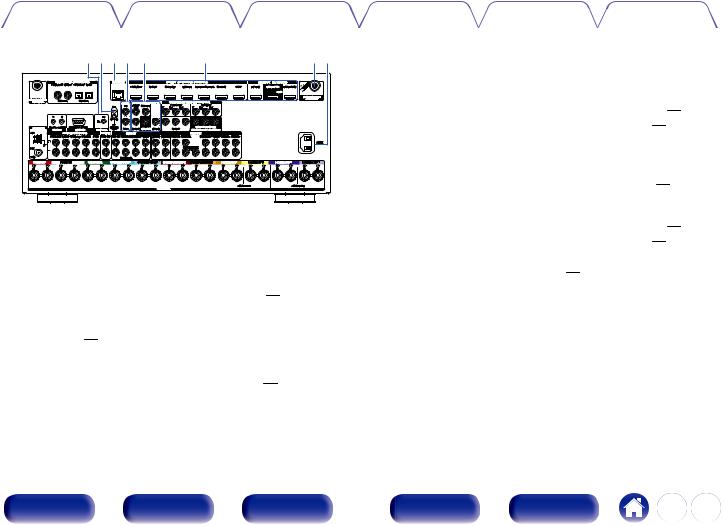
Contents |
Connections |
Playback |
Settings |
Tips |
Appendix |
|
|
|
|
|
|
tyui o |
Q0 |
qQ1 |
E FLASHER IN jack
Used when using a control BOX or other such control devices to control this unit.
F SIGNAL GND terminal
Used to connect a ground wire for the turntable. (v p. 85)
G NETWORK connector
Used to connect to a LAN cable when connecting to a wired LAN network. (v p. 90)
H REMOTE CONTROL jacks
Used to connect infrared receivers/transmitters in order to operate this unit and external devices from a different room. (v p. 92)
I Video connectors (VIDEO)
Used to connect devices equipped with video connectors.
0“Connection 3 : TV equipped without an HDMI connector” (v p. 80)
0“Connecting a set-top box (Satellite tuner/cable TV)” (v p. 82)
0“Connecting a DVD player or Blu-ray Disc player” (v p. 83)
J HDMI connectors
Used to connect devices equipped with HDMI connectors.
0“Connection 1 : TV equipped with an HDMI connector and compatible with the ARC (Audio Return Channel)” (v p. 78)
0“Connection 2 : TV equipped with an HDMI connector and incompatible with the ARC (Audio Return Channel)” (v p. 79)
0“Connecting a set-top box (Satellite tuner/cable TV)” (v p. 82)
0“Connecting a DVD player or Blu-ray Disc player” (v p. 83)
K AC inlet (AC IN)
Used to connect the power cord. (v p. 94)
Front panel |
Display |
Rear panel |
28 |
Remote |
Index |
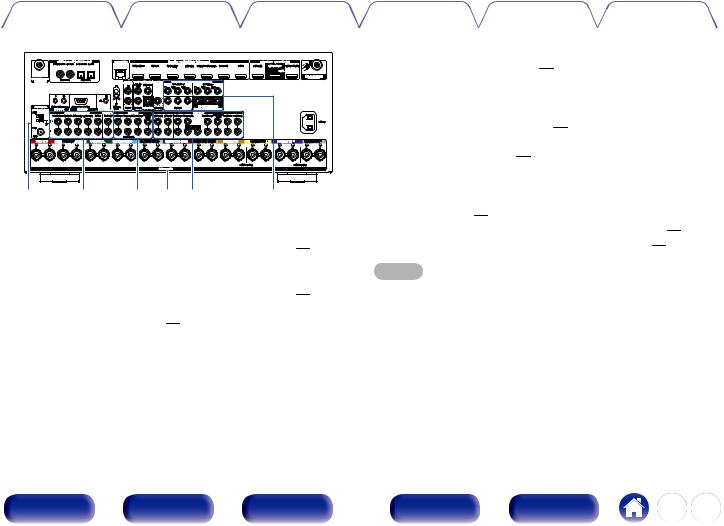
Contents |
Connections |
Playback |
Settings |
Tips |
Appendix |
|
|
|
|
|
|
Q2 |
Q3 |
Q4 Q5Q6 |
Q7 |
L FM/AM antenna terminals (ANTENNA)
Used to connect FM antennas and AM loop antennas. (v p. 88)
M Analog audio connectors (AUDIO)
Used to connect devices equipped with analog audio connectors.
0“Connecting a set-top box (Satellite tuner/cable TV)” (v p. 82)
0“Connecting a DVD player or Blu-ray Disc player” (v p. 83)
0“Connecting a turntable” (v p. 85)
N 7.1-channel input connectors (7.1CH IN)
Used to connect to a device that has multi-channel audio output connectors. (v p. 86)
O Speaker terminals (SPEAKERS)
Used to connect speakers. (v p. 44)
P PRE OUT connectors
Used to connect a subwoofer with built-in amplifier or an external power amplifier.
0“Connecting the subwoofer” (v p. 45)
0“11.1-channel playback” (v p. 64)
0“Connecting ZONE” (v p. 171)
Q Component video connectors (COMPONENT VIDEO)
Used to connect devices equipped with component video connectors.
0“Connection 3 : TV equipped without an HDMI connector” (v p. 80)
0“Connecting a set-top box (Satellite tuner/cable TV)” (v p. 82)
0“Connecting a DVD player or Blu-ray Disc player” (v p. 83)
NOTE
0Do not touch the inner pins of the connectors on the rear panel. Electrostatic discharge may cause permanent damage to the unit.
Front panel |
Display |
Rear panel |
29 |
Remote |
Index |
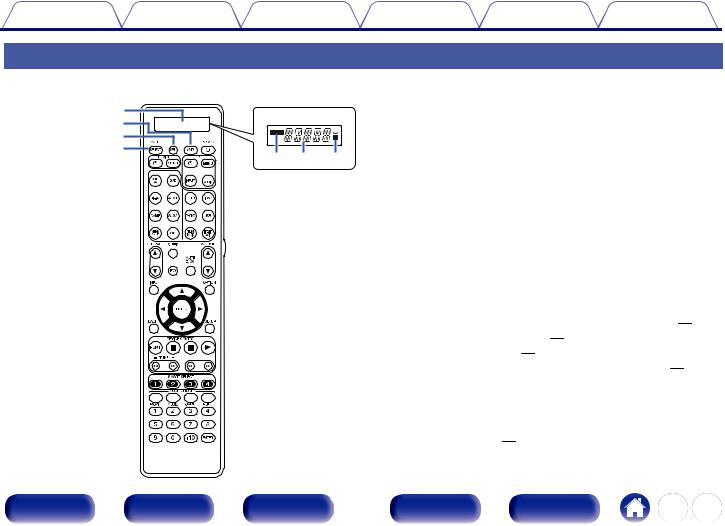
Contents Connections Playback Settings Tips Appendix
Remote control unit
|
|
|
A Display |
|
||
|
|
|
A LEARN indicator |
|
||
|
q |
|
|
This is lit when setting the learning function for the remote control unit. |
||
|
w |
|
|
(v p. 277) |
|
|
|
e |
|
B Information display |
|
||
|
r |
q w |
e |
0 |
This displays “AVR” when operating this unit. |
|
|
|
|
|
0 |
This displays the input source name when operating an external |
|
|
|
|
|
|
device. |
|
|
|
|
|
0 |
This displays “TV” when operating TV. |
|
|
|
|
C lindicator |
|
||
|
|
|
|
This is lit when signals are sent from the remote control unit. |
||
|
|
|
B AVR operation button |
|
||
|
|
|
When preset codes are registered to the remote control unit, press this |
|||
|
|
|
button and then operate the menu on the unit. |
|||
|
|
|
C SET button |
|
||
|
|
|
This is used for various settings on the remote control unit. |
|||
|
|
|
0 |
“Operating external devices with the remote control unit” (v p. 268) |
||
|
|
|
0 |
“Operating learning function” (v p. 277) |
||
|
|
|
0 |
“Setting the back light” (v p. 280) |
||
|
|
|
0 |
“Specifying the zone used with the remote control unit” (v p. 281) |
||
|
|
|
D ZONE SELECT button |
|
||
|
|
|
These switch the zone (MAIN ZONE, ZONE2, ZONE3) that is operated |
|||
|
|
|
through the remote control unit. |
|
||
|
|
|
0 |
“Playback in ZONE2/ZONE3” (v p. 177) |
||
|
|
|
0 |
“Menu operations” (v p. 183) |
|
|
Front panel |
Display |
Rear panel |
30 |
|
Remote |
Index |
